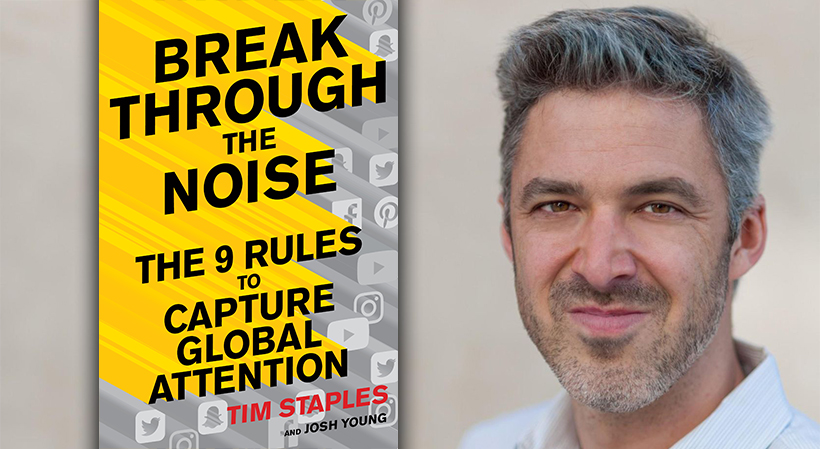The following is adapted from “Break Through the Noise: The 9 Rules to Capture Global Attention” © 2019 by Tim Staples and Josh Young. Reproduced by permission of Houghton Mifflin Harcourt. All rights reserved.
Selfie sticks used to be all the rage. Whether at the beach, the amusement park, or the mall, these narcissistic extension poles were everywhere, and they were getting longer. For much of 2015, there seemed to be an unofficial competition online to post the most ridiculous selfie-stick selfie, using the longest, most obnoxious arm.
The extending arm with a phone attached was also turning selfie sticks into a major nuisance. You’d be walking down the street, and everywhere you look, there’d be another pack of nylon-belt-bag tourists posing for a picture, their ring leader in the middle, holding a selfie stick that extended several feet in front of his face, swinging it side to side, making everyone smile so he could pull the trigger.
Things grew so out of control that Disney World officially banned selfie sticks out of safety concerns, after one park-goer tangled up his selfie stick in the car of a roller coaster, causing the ride to be shut down for an hour. Park officials declared that the long selfie sticks were a safety hazard to park-goers, especially to excited children who were running around and not looking out for them.
And the media loved every second of it. It seemed like every day there was a new story about the longest selfie stick or the latest corporate ban. Selfie-stick memes and jokes flooded the internet and became part of pop culture conversation.
Related: Why Messaging Matters
During this time, Pizza Hut approached us to produce a video promoting their new 2-foot-long pizza.
In hindsight, you can clearly see where this was going. As had become our normal process, we looked not only to the brand brief (the document that outlines the company’s goals for the project) for inspiration, but also to the internet. It didn’t take us long to connect the dots. An entertaining video based on the selfie-stick phenomenon was sure to be covered by major bloggers and online media outlets and would be highly shared.
This is what we call “riding the wave.” When you ride the wave, you catch the momentum of a pop culture topic, put your own spin on it, and, most important, add new value to the topic in some way.
One of the basic principles of shareability and breaking through the internet noise is that it is much easier to attach yourself to something that already has heat than to try to create that heat from scratch. Inserting your brand into trending topics can be one of the most effective ways to attract massive attention, but it can also back-fire in a major way, so you have to be very calculated in your strategy.
For Pizza Hut, we decided to reverse-engineer a campaign that would play right into this trend. We knew that the trend itself would lend us shareability, but how could we add value to the conversation? We needed to provide some pop culture commentary. We needed to have a point of view.
Did we love selfie sticks, or did we hate them? Were they fun, or a public nuisance?
Think about how either of those positions would be received by the public. If you love selfie sticks, and a brand comes out with a video that mocks them, your inner troll would rise up, and armies of annoyed selfie lovers would take to crushing the video in the comments.
On the other hand, what if you hate selfie sticks, and a brand comes out and tells you how much fun they are? You would eagerly dismiss that brand and call them out for callously riding the wave of a trending topic without a clue about what’s actually going on.
This is the danger of riding a wave. You can quickly crash and burn. The bigger the wave, the harder the fall. You need to find a perfect line and maintain your balance.
For us, we went through a rapid development phase where we created anything from fake documentary ideas to scripted comedy sketches, all while trying to find the right balance. At some far point, we were even thinking about crafting a fake-news story around homeless people using selfie sticks, to show just how far the trend had gone — it’s been said that there is no bad idea in development — but let’s just say we recognized pretty quickly that we were barking up the wrong tree!
Where we landed was a perfect sweet spot — we decided not to focus on the love or hate relationship with the selfie stick, but rather to focus on the underlying theme, the actual selfie. We felt that it was perfectly safe for Pizza Hut to love selfies. And if you love selfies, it’s not a very big leap to understand that selfie sticks are both an allure and a danger. We love selfies and selfie sticks, but if people keep making them longer and longer, the world will no longer be safe. Consequently, we may not be allowed to have them, and that poses a danger to the coveted selfie itself!
We felt that this approach was a comedic and circular argument that played to both sides, and it lent itself very naturally to a specific type of delivery, a mock public service announcement that hilariously presented the dangers of selfie-stick abuse. We cast a likable actress to play the role of a concerned mother, narrating from a gallery littered with selfies, explaining the glories of selfie culture and how these “Vainglorious Van Goghs” were being threatened by the selfie stick.
The video showed selfie-stick users in all kinds of ridiculous situations, from taking selfies in a bathroom stall to a cluster of people struggling to enter an elevator with their sticks at full extension, and a weightlifter extending one off the end of a barbell to capture his biceps at their most flattering angle.
My favorite was the convertible VW Bug with 10-foot selfie sticks poking out everywhere, whizzing through a neighborhood and wiping out a lemonade stand.
Sign Up: Receive the StartupNation newsletter!
In the midst of all the madness, a Pizza Hut delivery man came on to talk about how bigger selfies led to bigger parties, which led to bigger pizzas. “This had better show up on Instagram,” he says.
Until the end, when Pizza Hut’s logo came up over the final shot of the video, this very subtle integration was the only clue that the video was brought to you by a brand. It was all just pure entertainment, with zero hard sell. Even the end tag was delivered in line with the humor. As the logo comes on, our narrator calmly says: “Pizza Hut is a supporter of those suffering from selfie-stick abuse. Please selfie responsibly.”
The campaign was viral gold, rocketing up the YouTube charts and becoming the most shared ad in the world that month, while generating hundreds of articles and widespread media coverage.
Sure, the video was funny, but the reason it connected so well was because we found a line that both sides could laugh at, and we added something new to the conversation.
“Break Through the Noise: The 9 Rules to Capture Global Attention” is available now wherever books are sold and can be purchased via StartupNation.com.






